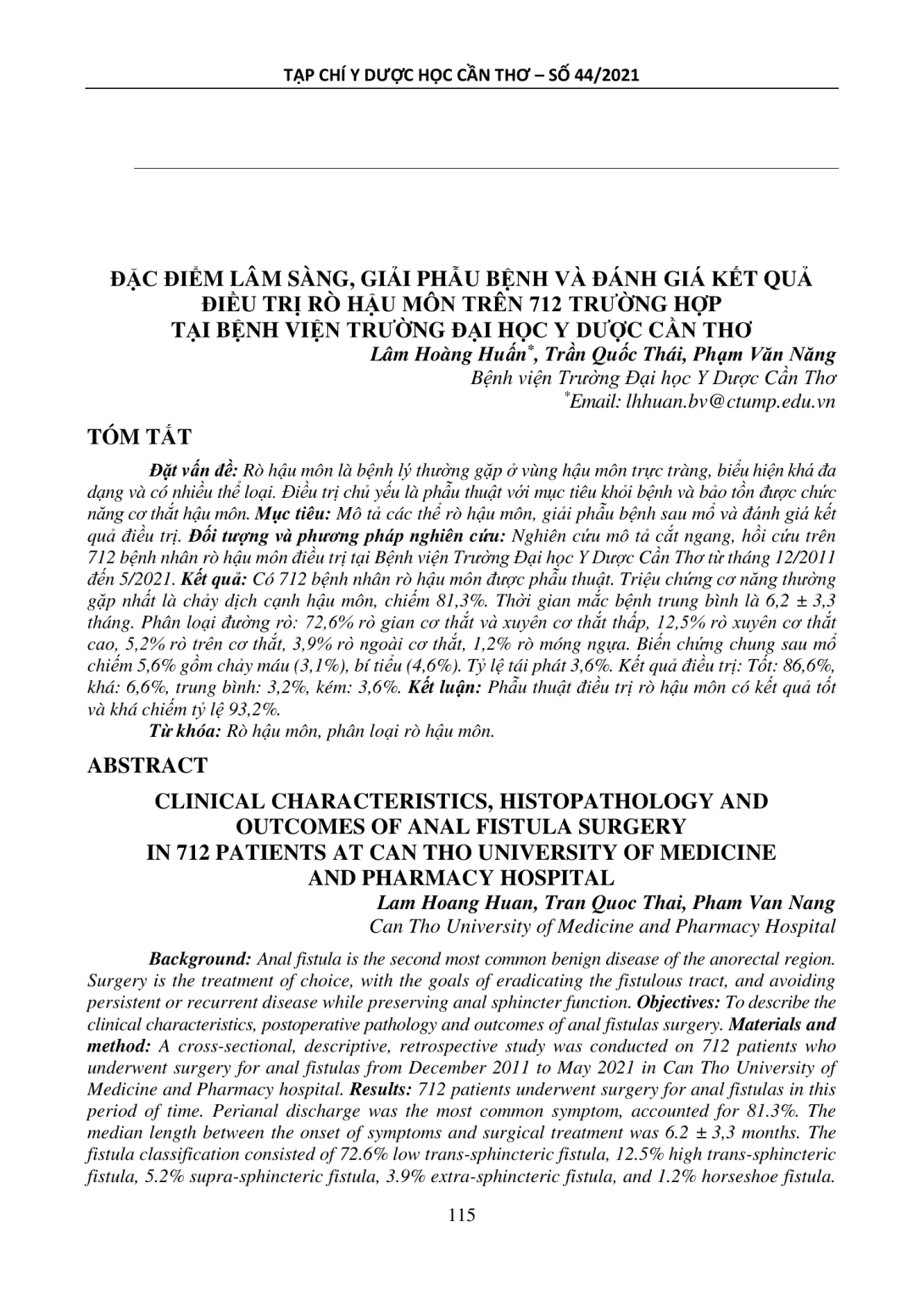
Rò hậu môn là bệnh lý thường gặp ở vùng hậu môn trực tràng, biểu hiện khá đa dạng và có nhiều thể loại. Điều trị chủ yếu là phẫu thuật với mục tiêu khỏi bệnh và bảo tồn được chức năng cơ thắt hậu môn. Mục tiêu: Mô tả các thể rò hậu môn, giải phẫu bệnh sau mổ và đánh giá kết quả điều trị. Đối tượng và phương pháp nghiên cứu: Nghiên cứu mô tả cắt ngang, hồi cứu trên 712 bệnh nhân rò hậu môn điều trị tại Bệnh viện Trường Đại học Y Dược Cần Thơ từ tháng 12/2011 đến 5/2021. Kết quả: Có 712 bệnh nhân rò hậu môn được phẫu thuật. Triệu chứng cơ năng thường gặp nhất là chảy dịch cạnh hậu môn, chiếm 81,3%. Thời gian mắc bệnh trung bình là 6,2 ± 3,3 tháng. Phân loại đường rò: 72,6% rò gian cơ thắt và xuyên cơ thắt thấp, 12,5% rò xuyên cơ thắt cao, 5,2% rò trên cơ thắt, 3,9% rò ngoài cơ thắt, 1,2% rò móng ngựa. Biến chứng chung sau mổ chiếm 5,6% gồm chảy máu (3,1%), bí tiểu (4,6%). Tỷ lệ tái phát 3,6%. Kết quả điều trị: Tốt: 86,6%, khá: 6,6%, trung bình: 3,2%, kém: 3,6%. Kết luận: Phẫu thuật điều trị rò hậu môn có kết quả tốt và khá chiếm tỷ lệ 93,2%.
Anal fistula is the second most common benign disease of the anorectal region. Surgery is the treatment of choice, with the goals of eradicating the fistulous tract, and avoiding persistent or recurrent disease while preserving anal sphincter function. Objectives: To describe the clinical characteristics, postoperative pathology and outcomes of anal fistulas surgery. Materials and method: A cross-sectional, descriptive, retrospective study was conducted on 712 patients who underwent surgery for anal fistulas from December 2011 to May 2021 in Can Tho University of Medicine and Pharmacy hospital. Results: 712 patients underwent surgery for anal fistulas in this period of time. Perianal discharge was the most common symptom, accounted for 81.3%. The median length between the onset of symptoms and surgical treatment was 6.2 ± 3,3 months. The fistula classification consisted of 72.6% low trans-sphincteric fistula, 12.5% high trans-sphincteric fistula, 5.2% supra-sphincteric fistula, 3.9% extra-sphincteric fistula, and 1.2% horseshoe fistula. The early postoperative complications rate was 5.6%, including hemorrhage (3.1%) and urinary retention (4.6%). The median wound healing time was 6.2 ± 2.49 weeks. The fecal incontinence rate was 3.8%. The postoperative recurrent rate was 3.6%. The outcomes of anal fistula surgery were good (86.6%), fairly good (6.6%), mild (3.2%) and poor (3.6%). Conclusion: The anal fistula surgery has good and fairly good results in 93.2% of patients.
- Đăng nhập để gửi ý kiến
